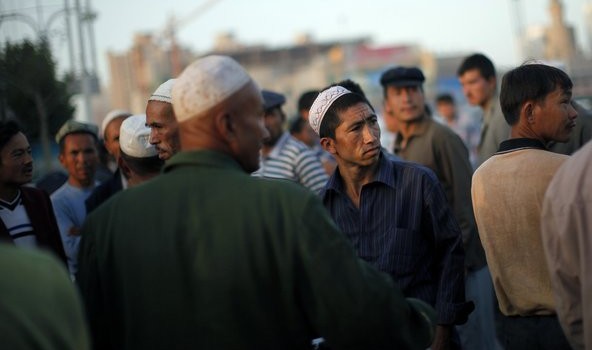Last week, 489 people from the far western region of Xinjiang got off a government-chartered train in the city of Guangzhou to start factory jobs in southeastern China. Mostly members of ethnic minorities, and in particular the Uighur minority, they are part of a labor export program that has been in place for years but is being stepped up as a result of orders from the top levels of the Communist Party.
The program has had its failures. In 2009, the appearance of 800 Uighurs from Shufu County in Xinjiang at a toy factory in Guangdong Province that employed 16,000 ethnic Han led to a mass brawl that resulted in the deaths of two Uighurs and the injuries of scores of others. A Uighur-led protest that July in Urumqi, the capital of Xinjiang, calling for an inquiry into those deaths led to China’s worst ethnic rioting in decades.
Uighurs are a mostly Muslim, Turkic-speaking people who are the largest ethnic group in Xinjiang, and they have long complained about rule by the Han, the dominant ethnicity in China. In violence this year involving Uighurs and Han, hundreds have died in Xinjiang and in Yunnan Province.
James Leibold, a professor at La Trobe University in Melbourne who studies China’s ethnic policies, said in an interview that the labor export programs had been in place since at least 2001. After coming to power in late 2012, Xi Jinping, the president and party leader, pushed an agenda for interethnic “contact, exchange and mingling,” Mr. Leibold said, and state media and government websites have run lengthy reports on interethnic marriage policies, mixed residency communities in Xinjiang, inland schools that take Uighur students and the labor export programs.
But it is difficult to find reliable estimates for the number of workers involved through the years in the labor programs.
“My understanding is that most who participate in these programs migrate within Xinjiang — for example Shufu County to Urumqi — and only a small number, now mainly female workers, go to coastal factories like these individuals,” Mr. Leibold said.
The Guangdong provincial government gives payments to companies that take on the workers, and on Oct. 20 it posted online what it called “trial” guidance for companies importing Xinjiang workers. The guidance, written by the Guangdong Provincial Management Bureau for Employment Services, details many aspects of the program. It was unclear why the bureau decided to post the guidance at that time.
The guidance says Guangdong is charged with taking workers from three areas of Xinjiang. Workers transferred from those places are mainly Uighurs whose education levels fall in the primary to junior high school range. Companies should assign the workers to simple jobs, the guidance says.
The workers are required to undergo “ideological and political review” by the local authorities. They also must be trained in speaking Mandarin Chinese, urban living and the law. For every 50 workers it exports, the Xinjiang government must assign a local official to accompany the workers, paying for his or her salary, as well as chefs to cook halal food at the factories.
The guidance says companies taking on the workers will be vetted by Guangdong officials. The companies are advised to cultivate ethnic minority role models. The companies should help the workers adapt to the local environment, such as enrolling children in schools or making hospital visits.
Although the companies should respect ethnic customs, they must also cooperate with the authorities, including the police and religious officials, to properly handle disputes, according to the guidance.
For their efforts, the accommodating companies will receive subsidies from the Guangdong government. The companies get a one-time payment of 3,000 renminbi, or $480, for every Xinjiang worker they hire, provided they hire at least 30 workers and retain them for at least one year. The companies also get a payment of 1,000 renminbi per worker if they offer a 60-hour program of adaptation training for the workers. The Guangdong government will also give a subsidy of 1,500 renminbi per month to each Xinjiang official accompanying the workers.
Mr. Leibold said it was unclear exactly what kind of preparation the current batch of 489 workers had undergone and how they compared to the group of 800 who arrived in 2009 at the ill-fated toy factory in Shaoguan, in Guangdong.
“Without further investigation, it’s impossible to know how similar this group is,” he said. “What are the conditions of their employment? How many men versus women? Are their levels of education and Mandarin higher than those of the Shaoguan group? How many Uighurs? How will they be housed and fed?”

Leave a Reply